This article needs additional citations for verification .(March 2021) |
Rabbi Avraham Brandwein (died February 20, 2013 [1] ), Admor of Stretin, was an Israeli Kabbalah scholar.
This article needs additional citations for verification .(March 2021) |
Rabbi Avraham Brandwein (died February 20, 2013 [1] ), Admor of Stretin, was an Israeli Kabbalah scholar.
Brandwein's family includes many chassidic masters, including the Maggid of Mezritsch, Elimelech of Lizhensk and Levy Yitschak of Berditshev, and he was directly descended from the first Admor of Stretin. Brandwein was born in Israel, the seventh generation in his family to live there. His family originally settled in Tsfat, the city of Kabbalists.
His father, Rav Yehudah Tzvi, was the previous Admor and a scholar of Kabbalah.
Brandwein served in the Israel Defense Forces in artillery and was among the soldiers that crossed the Suez Canal into Egypt during the Yom Kippur war.
Brandwein was ordained as a Rabbi by Gedolim representing the entire Orthodox community in Israel, and also holds an M.A. He integrated Charedi life with active participation in the life of the modern state. Brandwein served as a rabbi in the Absorption and Immigration Department of the Jewish Agency, providing spiritual assistance to recent immigrants.
From 1985, Brandwein taught Torah and Chassidut throughout Israel. He edited more than 20 volumes of classical Kabbalistic texts. He established a yeshiva in the Jewish Quarter of the Old City of Jerusalem where he taught Kabbalah. He wrote the book "The Essence of Religion and its Purpose" Commentary by "Or Hadash" Hebrew for New Light (Book Title in Hebrew "Mehut HaDat UMatrata") based on Rav Ashlag's article of the same name.
Brandwein died on February 20, 2013 (Hebrew Date Lunar Calendar is 10th of Adar), aged 67, in the Hadassah Medical Center in Ein Kerem in Jerusalem, after several months' illness. He was buried in the Mount of Olives Jewish Cemetery, next to his wife, Tzipora, who had died four years earlier. [1]
Rabbi Adin Even-Israel Steinsaltz was an Israeli Chabad Chasidic rabbi, teacher, philosopher, social critic, author, translator and publisher.
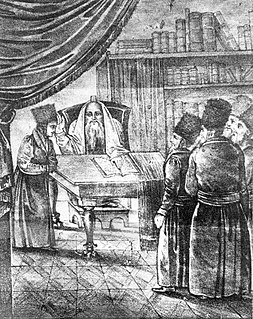
A Rebbe or Admor is the spiritual leader in the Hasidic movement, and the personalities of its dynasties. The titles of Rebbe and Admor, which used to be a general honor title even before the beginning of the movement, became, over time, almost exclusively identified with its Tzaddikim.
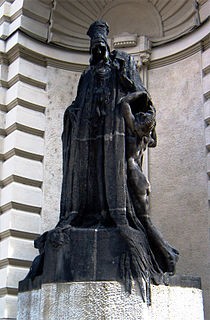
Judah Loew ben Bezalel, also known as Rabbi Loew, the Maharal of Prague, or simply the Maharal, was an important Talmudic scholar, Jewish mystic, and philosopher who, for most of his life, served as a leading rabbi in the cities of Mikulov in Moravia and Prague in Bohemia.
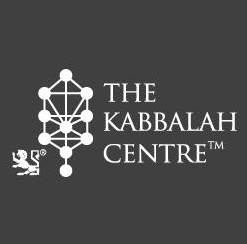
The Kabbalah Centre International is a non-profit organization located in Los Angeles, California that provides courses on the Zohar and Kabbalistic teachings online as well as through its regional and city-based centers and study groups worldwide. The Kabbalah Centre's presentation of Kabbalah was developed by its director, Philip Berg, along with his wife, Karen Berg.

Yosef Hayim was a leading Baghdadi hakham, authority on halakha, and Master Kabbalist. He is best known as author of the work on halakhaBen Ish Ḥai, a collection of the laws of everyday life interspersed with mystical insights and customs, addressed to the masses and arranged by the weekly Torah portion.

Rabbi Yehuda Ashlag (1885–1954) or Yehuda Leib Ha-Levi Ashlag, also known as the Baal Ha-Sulam in reference to his magnum opus, was an orthodox rabbi and kabbalist born in Łuków, Congress Poland, Russian Empire, to a family of scholars connected to the Hasidic courts of Porisov and Belz. Rabbi Ashlag lived in the Holy Land from 1922 until his death in 1954. In addition to his Sulam commentary on the Zohar, his other primary work, Talmud Eser Sefirot is regarded as the central textbook for students of Kabbalah. Ashlag systematically interpreted the wisdom and promoted its wide dissemination. In line with his directives, many contemporary adherents of Ashlag's teachings strive to spread Kabbalah to the masses.

Yitzhak Kaduri, also spelled Kadouri, Kadourie, Kedourie; "Yitzhak", was a renowned Mizrahi Haredi rabbi and kabbalist who devoted his life to Torah study and prayer on behalf of the Jewish people. He taught and practiced the kavanot of the Rashash. His blessings and amulets were also widely sought to cure people of illnesses and infertility. In his life, he published no religious articles or books. At the time of his death, estimates of his age ranged from 103 to 108, and his birth year is still disputed.

Philip S. Berg was an American rabbi and dean of the worldwide Kabbalah Centre organization.
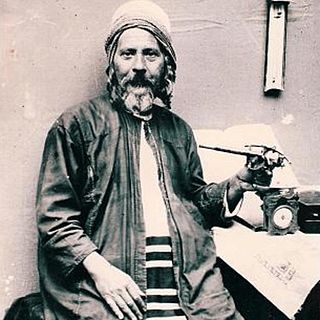
Yiḥyah Qafiḥ (1850–1931), known also by his term of endearment "Ha-Yashish", served as the Chief Rabbi of Sana'a, Yemen in the late nineteenth and early twentieth centuries. He was one of the foremost rabbinical scholars in Sana'a during that period, and one who advocated many reforms in Jewish education. Besides being learned in astronomy and in the metaphysical science of rabbinic astrology, as well as in Jewish classical literature which he taught to his young students.

Shlomo Elyashiv (Eliashov), also known as the Leshem or Ba'al HaLeshem, was a famous kabbalist, who was born in Šiauliai, Lithuania, and later moved to the Land of Israel.
There are a number of honorifics in Judaism that vary depending on the status of, and the relationship to, the person to whom one is referring.

Shaar Hashamayim Yeshiva is an Ashkenazi yeshiva in Jerusalem dedicated to the study of the kabbalistic teachings of the Arizal. It is famous for its student body of advanced kabbalists — many of them roshei yeshiva and Torah scholars — as well as beginning and intermediate scholars who study both the revealed and concealed Torah.
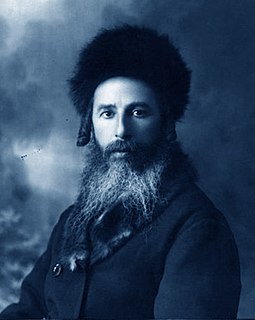
Chaim Yehuda Leib Auerbach was a Haredi rabbi and roshei yeshiva of Shaar Hashamayim Yeshiva, a landmark Jerusalem institution specializing in Talmudic and kabbalah studies for Ashkenazi scholars that he helped found in 1906. The yeshiva still exists today. Known for his great love and personal sacrifice for Torah and Torah scholars, Auerbach raised sons who also became great scholars — including his eldest son, Rabbi Shlomo Zalman Auerbach, a preeminent posek of the mid- to late-twentieth century.

Yochanan Sofer was the Rebbe of the Erlau dynasty, which though not the largest in the number of its adherents is still a significant movement within Haredi Judaism. He was born in Eger (German: Erlau), Hungary, where his father and grandfather served as Grand Rabbis. After surviving the Holocaust, he continued their legacy by founding a yeshiva and a movement in their name, first in Hungary and then a few years later in Jerusalem.
Rav Yehuda Leon Ashkenazi, also known as Manitou, a Jewish rabbi and educator, was a spiritual leader of 20th century French Jewry.
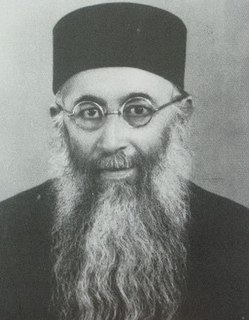
Yaakov Hai Zion Ades, also spelled Adas or Adess, was a Sephardi Hakham, Rosh Yeshiva, and Rabbinical High Court judge. As rosh yeshiva of Porat Yosef Yeshiva in Jerusalem, he raised thousands of students, including Rabbi Ovadia Yosef, Sephardic Chief Rabbi of Israel; Rabbi Ben Zion Abba Shaul, rosh yeshiva of Porat Yosef; and Rabbi Yehuda Hakohen Rabin, Chief Rabbi of Bukharan Jewry in Israel.

Avrohom Yaakov Friedman was the fifth Rebbe of the Sadigura Hasidic dynasty. In 1979 he succeeded his father, the fourth Sadigura Rebbe, and took his seat on the Moetzes Gedolei HaTorah. He oversaw the growth of Sadigura communities in Israel and in London, Antwerp, and New York City.

Bnei Baruch is a universalist kabbalah association founded by Michael Laitman in the early 1990s. It is estimated to have around 50,000 students in Israel, and some 150,000 around the world.

Oury Amos Cherki is chairman of Brit Olam – Noahide World Center, a senior lecturer at Machon Meir, leader of congregation "Bayt Yehuda" in the Kiryat Moshe neighborhood of Jerusalem, and has published numerous works on Jewish thought and philosophy.
RabbiYosef Haim HaCohen was the President of the Ma’araviim Community in Jerusalem, as well as the rabbi, dayan, shadar and rabad of the congregation.